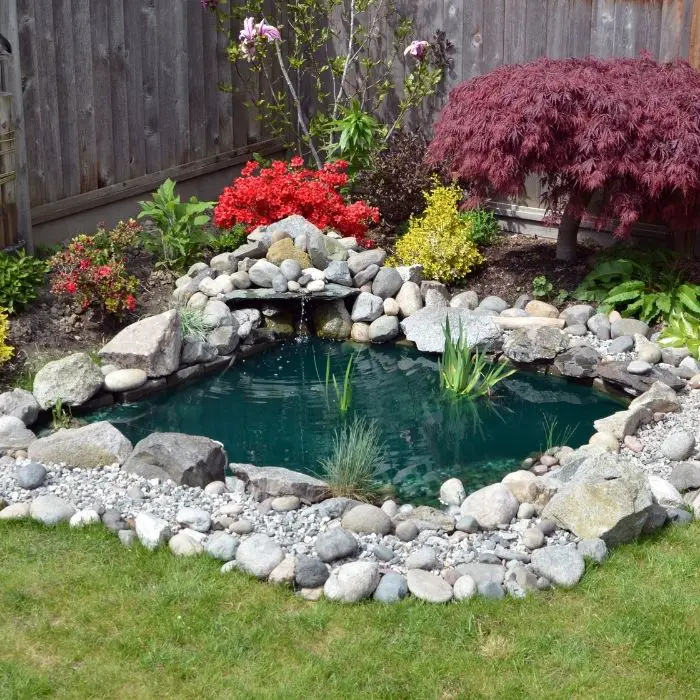Can A Backyard Pond Be On A Slope?
When planning a backyard pond, it’s important to consider the natural qualities of the terrain. For example, many people’s properties are not level and the only space available for the pond is on a slope. Is it OK to build a backyard pond on a slope?
Yes, building a backyard pond on a slope is possible and actually quite common. To build your pond on a slope, you either have to level it beforehand or be prepared to build a dam, embankment or retaining wall on the downward side of the slope. Building a pond on a slope without leveling or damming risks losing the water to gravity as it runs out of the pond and down the slope.
Building a pond always comes with challenges and a slope is just one of many. Thankfully with the right knowledge and proper planning, the challenge of building on a slope can be as fruitful as it is rewarding.
Does A Pond Need To Be Level?
In general, a pond’s bottom does not need to be leveled to be built on a slope as long as there is a dam or retaining wall present on the downward side of the slope. This is called an embankment pond. With this being said, many people may choose to level their slope first to avoid the challenges of building a dam or the risk of the dam breaking and losing their pond’s water to gravity.
Alternatively, you can employ a combination of both methods. This would involve taking some of the soil from the upper side of the slope and piling it into a dam on the downward side until the two sides are roughly equal and the water is level. In this scenario the bottom of the pond would not be level but the dam on top would prevent any spillage due to the gravity of the slope.
How To Build A Backyard Pond On A Hill Or Slope
Building a pond on a slope doesn’t have to be any more difficult than building a pond on level terrain as long as you consider all the variables involved.
One of those variables is the location of the pond on the slope. If the pond is at the top of the slope, there are few challenges besides digging out the pond and constructing the dam or container wall. However, if the pond is at the bottom of the slope you’ll need to plan for contending with water running down the top of the slope or hill and overflowing your pond.
In the case of a pond at the bottom of the slope, you’ll need to construct a spillway. A spillway is an emergency pathway or channel installed to carry excess water out of the pond to maintain the water level and avoid overflowing or erosion of the dam. Spillways can be constructed out of rocks, cement, treated wooden planks or piping.
In addition to the spillway, an emergency spillway can also be installed in case of more drastic flooding to protect the dam or embankment from submerging underwater. Typically, both spillways will channel the excess water around the dam and into some sort of drain. Ideally, the water should be channeled so that it flows slowly in order to avoid erosion or damage to your property or pond.
How To Build A Pond Dam Or Embankment
When building on a slope, a properly constructed pond dam or embankment is absolutely necessary to the integrity of your pond.
The most common kind of pond dam or embankment is constructed simply of earth piled onto the downward slope of the pond. In general, your earthen embankment should be composed of 2 parts clay and 1 part sand or soil. This ensures that the dam is strong and waterproof enough for the weight of the water in the pond and resistant to water seeping through cracks in the soil.
Alternatively, the dam can be constructed of planks of wood and stakes in the ground propped up with large rocks. Whatever material you choose, just make sure the dam is strong enough to hold back the weight of the water in the pond without cracking or collapsing altogether.
The height of the dam is important as well and should be constructed about 2 feet, as a rule of thumb, above the water level to account for rainfall or drainage coming from the top of the slope, if applicable.
You may also want to consider making sure the areas around your dam are covered in thick grass or some kind of stone to avoid erosion of your property in the event of runoff or overflow.
Related Questions
How Do You Build A Pond On Uneven Ground?
For a preformed pond, when you’ve finished digging out and excavating the pond site, cover the base of the pond with clay and soil to level it out. Install the pond according to the manufacturer’s instructions and fill the sides with soil until it’s even. For a traditional pond, you can employ the stake method by driving a stake to the desired depth into the middle of the pond and attaching a beam to the ground around the outside. You can then use a spirit level to see if the pond is level.
Can You Build A Pond On A Slope?
Yes, a pond can be built on a slope as long as the ground is either leveled or an embankment or dam is installed on the downward side of the slope. Either of these methods prevents water from spilling out of the pond due to gravity and helps to maintain the depth of the water.
What Is The Best Shape For A Pond?
The best shape for a pond is one with rounded corners. The shape of the edging above water on land doesn’t matter but under the water the edges should be rounded to ensure proper water flow.
How Deep Should A Pond Be?
I general, a pond with fish and plants and other fauna should be at least 2 feet deep. This kind of depth is good enough to prevent evaporation in the summer and freezing in the winter and will allow the fish and plants to thrive all year long.






